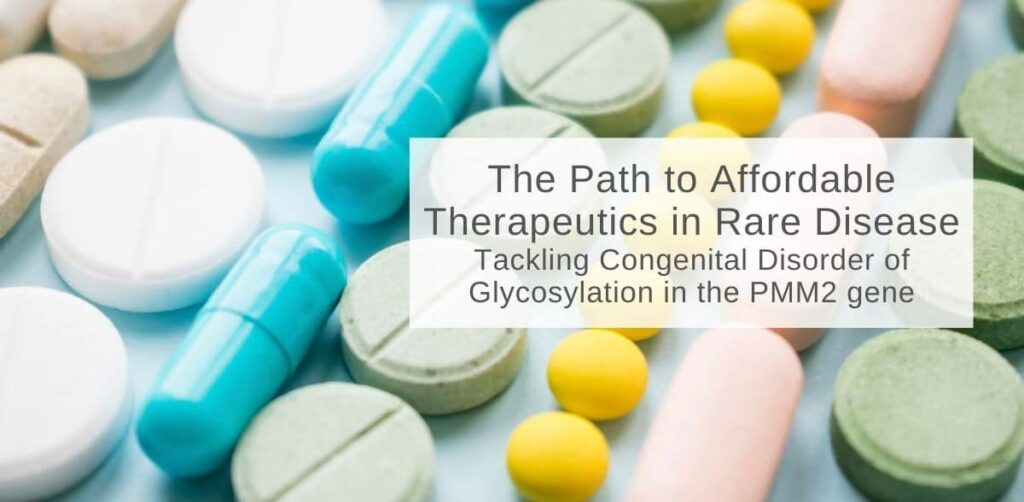Summary
Rare diseases are just that: rare. However, when combined rare diseases affect 3.5% – 5.9% of the worldwide population, and present a growing healthcare issue. In this article we talk with Dr. Sangetha lyer about her work at the biotech company Perlara and highlight their recent successes in a drug repurposing effort for PMM2-CDG.
Introduction
By definition, there are not a lot of patients for any given Rare disease, as a disease is only considered rare (or “orphan”) if it affects fewer than 200,000 people (NIH). Often, a rare genetic condition causing a malfunction of a gene is even more infrequent, with maybe a handful of people, or one singular person, on the planet sharing similar genetic lesions in a given gene. Despite this, rare disease as a group is actually quite common. There are over 7,000 genes in everyone’s genome that can harbor a gene variation which leads to a disease. One way to conceptualize the variants in a rare disease is to imagine an inverted image of a galaxy, where black dot clusters of Rare variants have different levels of phenotypic severity (Figure 1). The variant clusters in the outer fringes are near normal activity, but in the center is the black null of lethality.

Figure 1. Adapted from the European Space Agency
Although a pair of individuals with similar variations in a given gene is not often found, the likelihood that any two individuals will have a defective variation in any one of the 7,000 genes is much higher. The result is that about 1 in 15 persons are afflicted with a rare disease condition. So, in aggregate, it turns out that rare diseases are a highly common health care issue that suppresses quality of life for a large proportion of the planet’s population.
The challenge of today’s personalized medicine is to develop therapeutic approaches that can treat these rare disease populations in a cost effective way. In the traditional therapeutic development path, the cost to bring a chemical entity through the challenges of toxicity and efficiency and have it reach the market, has cost billions of dollars. This sizable sum of money can be challenging to justify when only a dozen or so individuals will stand to benefit from such a high cost. As a society, we must get inventive and find more affordable approaches to bring rare disease therapeutics to market. Answering this call to action are small biotech companies, such as Perlara.
Perlara, located in the San Francisco Bay Area, was founded in February 2014 by Ethan Perlstein. The company is “on a mission to accelerate the discovery of cures for rare genetic diseases and uncover underlying mechanisms that enable the development of treatments that work across a range of diseases and individuals” (Perlara Website). Through their PerlQuests™, Perlara partners with families, researchers, and patients to find treatments for these otherwise forgotten, yet very real, rare diseases. One such PerlQuest, focusing on PMM2 (Phosphomannomutase 2 deficiency), holds a special place in the heart of Dr. Sangeetha Iyer, the Director of Preclinical Development at Perlara.
Dr. lyer (currently a senior PM at Pfizer) has a background in neurodegenerative disorders and rare genetic diseases. She received her Ph.D. in molecular pharmacology from the University of Pittsburgh and then went on to do her postdoc research at the University of Texas, Austin. Sangeetha has worked with a plethora of models, starting her career with mouse models, and working with xenopus oocytes, drosophila, and C. elegans. Not only does she have a wide understanding of model organisms, but Dr. lyer also has had over 10 years of experience in model and assay development and drug screening for human genetic disorders.
Dr. lyer developed nematode models of rare diseases and conducted several successful screen campaigns for rare diseases, one of which was the aforementioned PMM2, the Phosphomannomutase 2 deficiency. These efforts led to a clinical trial with one patient, Maggie (n=1). The trial outcome was a success! Maggie is doing quite well and the trial is currently being expanded to include other patients. Recently, these findings were published in a paper titled: Repurposing the aldose reductase inhibitor and diabetic neuropathy drug epalrestat for the congenital disorder of glycosylation PMM2-CDG.
What is PMM2?
PMM2-CDG, formerly known as congenital disorder of glycosylation type 1a, is a rare multisystem disorder that involves a normal, but complex, chemical process known as glycosylation (PMM2-CDG 2015)

Figure 2. PMM2 enzyme
PMM2-CDG is caused by mutations of the phosphomannomutase-2 (PMM2) gene and is inherited as an autosomal recessive condition. The variation reduces the function of the PMM2 enzyme and leads to improper levels of glycosylation. The disease can affect any part of the body, though most cases usually have an important neurological component. PMM2-CDG is associated with a broad and highly variable range of symptoms and can vary in severity from mild cases to the severe, disabling or life-threatening cases. Most cases appear in infancy or early childhood, like in Maggie’s case, thus, this patient population became the focus of Perlara’s PerlQuest.
Maggie’s Quest
The PMM2 PerlQuest came about because, prior to meeting Maggie, Dr. lyer had started working on lysosomal storage disorders. The research team had just completed some work on a glycosylation disorder (NGLY-1), whose loss of function leads to developmental delay and seizures. In presenting this work, they were introduced to the Maggie’ parients, as PMM2 deficiency is one of the most common causes of glycosylation disorders. Sangetha and the team at Perlara felt this was a good candidate for using humanizing mutations to create an animal model of the disease in a simple model organism.
“Some model systems work, but not a whole lot and we felt that it fit very well with our platform of model organisms. Perlara was working with yeast model systems, drosophila as well as C. elegans along with the basic model organism pipeline and on the other hand, we had patient fibroblast, which were also available for PMM2. So PMM2 basically came onto our radar because of Maggie, the girl who has PMM2 disorder. And after meeting with her parents and having some conversations about the utility of our platform, we decided to go ahead and model some of our mutations and see if we could conduct a drug screening campaign. That’s how that program came to be.” (Iyer, Podcast: 17 minutes of Science, 2020)
To pursue PMM2 treatment options, Sangeetha and her team at Perlara decided to go down the path of drug repurposing. This involves testing already known drugs and compounds in alternative ways to see if they are viable treatment options for other diseases outside of their initial purpose. One of the main benefits of drug repurposing is that it speeds up the traditional drug discovery timeline as the compounds are already known, and often have vast amounts of information already available for researchers to use. As a result, drug development can be achieved while cutting costs immensely: instead of the typical hundreds of millions it takes to reach clinical trials, drug repurposing trials can be conducted with millions or even sub-millions.
The process:
To begin their repurposing campaign, researchers at Perlara initially started testing with yeast models of PMM2. They then wanted to move into C. elegans, but hit a roadblock. C. elegans already had one PMM2 model, but it was lethal which meant it would not be a viable tool for their campaign. At this point, Perlara approached InVivo Biosystems for help building a new C. elegans model to use. “With InVivo Biosystems’ help, we were able to model another, a different patient mutation, one that does not have this severe lack of enzyme activity”(Iyer, Podcast: 17 minutes of Science, 2020). The new worm model that InVivo Biosystems built for Perlara has an ortholog for PMM2 in which the protein is 54% identical to humans. This may not sound like a lot, but it is very significant. Additionally, and possibly most importantly, the mutation sites were conserved between humans and C. elegans. Because of this conservation, Perlara was able to use the C. elegans models engineered with a specific point mutation that modeled the exact mutation seen in the patient.
“One of the reasons we believed in the power of model organisms specifically for rare monogenic diseases was because when you have a single gene ortholog and one that has high similarity to what one might encounter in humans, you can model the same mutation as you see in humans, in those model organisms.” (Iyer, Podcast: 17 minutes of Science, 2020).
Dr. lyer performed a drug screen using a 2560-compound Microsource Spectrum library consisting of FDA-approved drugs, bioactive tool compounds and natural products. The top 20 hits were found to be either antidiabetic or antioxidant molecules. Remarkably, the dominant portion of hits were antioxidant flavonoids with known utility as aldose reductase inhibitors (ARIs). Next they checked the activity of the leads in yeast and patient-derived fibroblast to see if cross species conservation of activity can be observed. The result was identification of α-cyano-4-hydroxycinnamic acid (CHCA) as the most cross species bioactive for ARI activity. The structure activity relationship of the CHCA molecule was used to develop a drug pharmacophore profile which allows identification of a set of commercially-available ARIs (tolrestat, ranirestat, imirestat, zopolrestat, sorbinil, ponalrestat, alrestatin, fidarestat and epalrestat). Testing these new molecules in worms and patient fibroblast revealed epalrestat as the best activity lead.
The aldose reductase is an enzyme that shunts glucose down the polyol pathway with its conversion of glucose into sorbitol. The inhibition of this enzyme activity has two favorable effects. It leads to an increase in glucose-1,6-bisphosphate production which activates PMM2. And it prevent activation of the polyol pathway activity which generates Reactive Oxygen Species (ROS) and leads to Advanced Glycation End-products (“AGE”). The AGE are especially nasty because they create abnormal protein glycosylation and cause a normal protein to be recognized by the immune system as “foreign” protein. Then a cascade of auto-inflammatory response is initiated.

Figure 3. Polyol Pathway
It is likely PMM2 deficiency set in motion quite a few cellular stress responses. Not only does it result in reduction in normal levels of N-linked glycosylation, it also results in increased shunt of glucose through the polyol pathway. This leads to high levels of sorbitol which readily alkylates with the amines in the body’s proteins rendering the proteins a “foreign” in appearance to the immune system and inflammation results. This ripple effect of cellular stress stress leads to the clinical presentations of the disease.
“Until the time that we did this work, nobody had discovered that you could boost PMM2 enzyme activity through some other artificial shunt pathway, which is essentially what our model organism screens were telling us, that there was another way to increase PMM2 activity.” (Iyer, Podcast: 17 minutes of Science, 2020).
And while this was true, they had discovered another way to increase PMM2 activity in both their yeast and worm models, they were not certain how this would translate to the human enzyme. At this point, Dr lyer and her team at Perlara were able to incorporate the human fibroblasts which were known to have the defective enzyme activity. The team used both generic Fibroblasts from Coriell, a non-profit repository for patient fibroblasts, in addition to using the fibroblasts from Maggie. In both cases, the fibroblasts showed that PMM2 enzyme activity was in fact increased when exposed to epalrestat. According to Dr lyer, “that’s where the final piece of the puzzle came together.”
Maggie’s Cure
One of the benefits of drug repurposing over developing new compounds is that these drugs are already on the market and have had a wealth of safety data collected. While not always the case, this typically makes it easier to get approval to use the drugs. Although epalrestat had never been approved for use in the US, it had been on the market for over 20 years in other countries and was no longer under patent protection.
At this point, Perlara started talking with Maggie’s family and Dr. Eva Morava from the Mayo Clinic to see about treatment opportunities for Maggie using epalrestat. Dr. Morava, along with Maggie’s parents and Ethan Perlstein, put together an n=1 IND application which they submitted to the FDA in order to gain approval for the use of epalrestat. Thanks to the trove of safety data that was available for epalrestat and the body of data generated by Perlara substantiating that epalrestat increased PMM2 enzyme activity in a variety of modern systems, they were able to gain approval for the trial.
Maggie has now been on the drug for over a year (Interview conducted when Maggie had been on the drug for about 10 months). She has gained weight and can have conversations, something she was unable to do pre-treatment. Her motor skills and coordination have skyrocketed — she can even ride a bike now. Maggie is continuing to take epalrestat, and her team is now working to expand the trial to a larger group in the hopes of helping others. Dr lyer credits the success of this drug repurposing study to the model organisms which were able to generate the data they needed quickly, efficiently, and affordably in order to gain their FDA approval.
“To see a drug have an impact, a positive impact, on the child, in a child was just incredibly powerful” (Iyer, Podcast: 17 minutes of Science, 2020)
Propel your drug discovery research to new horizons. Contact us today to unlock our comprehensive drug discovery services and revolutionize the future of medicine.
References
- Aldose Reductase Inhibitors for the Treatment of Diabetic Polyneuropathy. www.cochrane.org/CD004572/NEUROMUSC_aldose-reductase-inhibitors-for-the-treatment-of-diabetic-polyneuropathy#:~:text=Aldose%20reductase%20inhibitors%20are%20a,or%20reverse%20progression%20of%20neuropathy.
- Cheesman, Sarah, and Sangeetha Iyer. “From Bench to Bedside: Using Model Organisms to Find Rare Disease Treatments.” 10 Nov. 2020, invivobiosystems.com/17-minutes-of-science/from-bench-to-bedside-using-model-organisms-to-find-rare-disease-treatments. Accessed Mar. 2021.
- Iyer, Sangeetha, et al. Repurposing the Aldose Reductase Inhibitor and Diabetic Neuropathy Drug Epalrestat for the Congenital Disorder of Glycosylation PMM2-CDG. 11 Nov. 2019, journals.biologists.com/dmm/article/12/11/dmm040584/223279/Repurposing-the-aldose-reductase-inhibitor-and.
- PMM2-CDG. 6 Aug. 2015, rarediseases.org/rare-diseases/pmm2-cdg/#:~:text=Summary,chemical%20process%20known%20as%20glycosylation.
- Ravichandran Ramasamy and Ira J. Goldberg, et al. Aldose Reductase and Cardiovascular Diseases, Creating Human-like Diabetic Complications in an Experimental Model. 14 May 2010, www.ahajournals.org/doi/10.1161/circresaha.109.213447.





